The Female Body in Art as a Non-Sexualised Being
The female body in an artistic form has always had the capability to arose and ignite sexual passions. The admirable marble statues from the age of antiquity, the teasingly seductive rococo portrays and surrealist muses depicting impulsive lust, female bodies throughout art history have been objects of desirable, self-gratifying pleasure. Yet there have been artists capable of presenting the female body as a non-sexualised object. These artists used female body to subvert traditional meanings or make them an extension of allegories. Their work gives credence to female bodies having the ability to transcend beyond other artists’ or observers’ need for self-gratification.
Miru Kim: Naked City Spleen
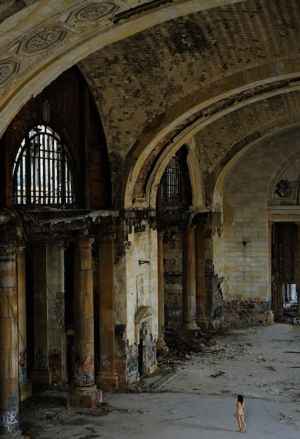
Miru Kim stated Naked City Spleen‘s aims was to merge her physicality with urban spaces. As a result, Kim felt “I momentarily inhabit these deserted sites, they are transformed from strange to familiar, from harsh to calm, from dangerous to ludic” [1]. Kim used her body as a representation of humanity, how we are physically and consciously connected to our surroundings, a relationship which can be flawed. Michigan Central Station is a pivotal example. Michigan Central Station became the world’s tallest rail station when opened in 1913 and was modeled upon classical architecture. However, its declining usage and expensive upkeep meant closure in 1988 and has since been in ruins. The composition’s vast space dwarfs Kim in the foreground by a once glorious, man-made structure reflects societies’ superficial sense of superiority. Places like Michigan Central Station can be forgotten from humanities’ consciousness, yet a human rediscovering themselves in an abandoned space through their physicality makes us realise that no matter how much society achieves, there will always be a threat of decay. Michigan Central Station‘s use of color, particularly capturing the stained colors of the stations decay, signifies the interpreted theme.
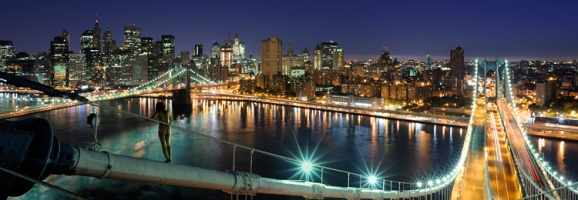
Manhattan Bridge documents the structure of the same name, which allows passage for cars, trains, pedestrians and bicycles. Thus Manhattan Bridge is a major part of New York citizens’ daily journeys, a relevant location for Kim’s exploration of the relationship between humanity and urban spaces. Kim described her feelings in conducting Manhattan Bridge, “when I climbed to the top I could look down to appreciate its beauty, while feeling the entire bridge vibrate every time the subway trains passed by” [2]. Kim conveys the vibrancy of Manhattan Bridge as an urban structure through making observers personify her description through her body, also expressed through New York City’s bright artificial colors. As in Michigan Central Station, Kim is a minimal figure engulfed in the foreground by urban consumption, which is symbolic. Kim in the nude emphasises humanities’ relationship with urban spaces, how our interactions can be rushed and that there is a fundamental need to observe our surroundings. If anyone does not take this interpretation, then there is a danger of humanities’ relationship with urban spaces leading to over consumption.
Ruth Bernhard: Vulnerability in Female Form
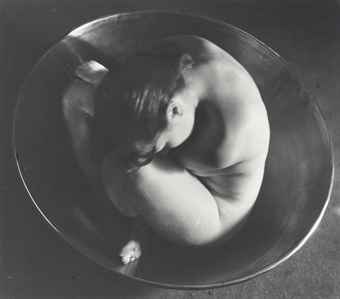
Ruth Bernhard’s photography is most widely known for her studies of female bodies. Bernhard stated that “my aim is to transform the complexities of the figure into harmonies of simplified forms, revealing the innate reality” [3]. Bernhard wanted to reflect the female body as a natural, rather than sexual entity through minimalist aesthetic and black and white photography. Early 1950s Study reflects the female body in a state of vulnerability. The composition’s angle is reminiscent of a fetus in a womb. Fetuses of both genders are born from this position, indicating equal status. Early 1950s Study represents the female body as a distinctively human rather than sexual being. Yet the fetus position also conveys a fragile state. Bernhard is also emphasising that despite an equal biological status, the female body is still in a vulnerable state due to others’ self-gratification.
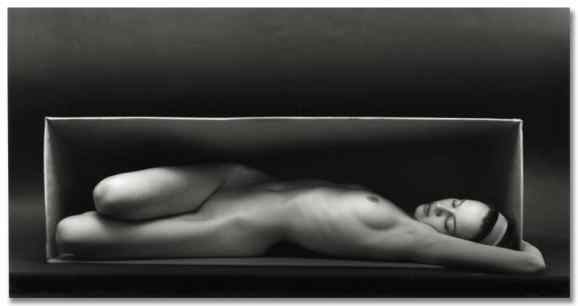
In a Box (Horizontal) continues to reflect Bernhard’s trend of representing the female bodies’ vulnerability. The subject is struggling to move in an enclosed space. Her pose has an underling subversion of the female bodies’ representation. She is lay in a position where her body is exposed, a pose commonly used in art to ignite an observer’s sexual arousal. Since the subject is posing within a minimal setting, it is not a composition where any sexual thoughts are being produced. Instead, the minimalism makes observers see a female body as a human being. However, In a Box (Horizontal)‘s use of enclosed space creates an interpretation that the female body can be threatened through any form of violence.
Spencer Tunick: Naked States
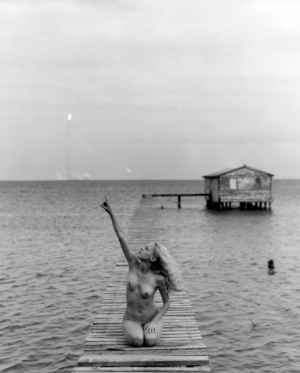
Spencer Tunick defined the female body as an extension of humanities’ connection with our natural environment, “the bodies extend into and upon the landscape like a substance. These grouped masses which do not underscore sexuality become abstractions that challenge or reconfigure one’s views of nudity” [4]. Tunick’s aesthetic direction is to personify female bodies in reaction to their surroundings. Florida‘s composition merges humanities’ relationship to natural and artificial environments. The subject engages with the ocean in her natural form, reflecting nudity as a part of nature, yet her focus is upon a rocket which has set off in the distance. Florida can be interpreted as humanities’ flawed relationship between the natural and artificial. The subject is comfortable in natural surroundings, yet apprehensive about how far artificial technology can go. She is symbolic of humanity, her nudity transcends our vulnerability towards controlling a balance between natural and artificial environments.
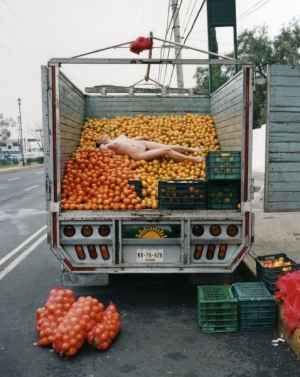
Mexico, D.F. (Copilco) continues the examination of humanities’ relationship between the natural and artificial. The subject is lay down on fruits that will be soon be consumed by a large populous. Her position has a symbolic quality in relation to the natural and artificial. Humanities’ need to consume can turn to extravagant levels, meaning there is a danger of meaningless waste caused by industrial methods. This can be a destructive path where humanity can take itself. The subject lay upon the fruits can be seen as a sign of vulnerability through composition and color theme of bright fruits and pale skin, symbolising where humanity could end up if extravagance continues.
The female body has the ability to transcend beyond sexual representation, depending upon an artist’s intentions. While there has been and still are artists who use the female body to symbolise sexuality, there have been other artists able to portray the complete opposite. Artists adamant in using the female body for subversive purposes were able make observers see their own representation by not appealing to self-gratification. These artists’ works reflect universal themes, which the female body symbolises. Thus observers see the female body as a part of themselves rather than a sexual object.
Works Cited
1. Kim., M. 2008. ‘POPULATING MY SOLITUDE’. mirukim.com. [Accessed Online][Available From] – http://mirukim.com/statementNakedCitySpleen.php
2. Kim., M. 2008. ‘Manhattan Bridge’. mirukim.com. [Accessed Online][Available From] – http://mirukim.com/photosNakedCitySpleen.php
3. Anonymous., 2009. ‘About the Photographer’. photographywest.com. [Accessed Online][Available From] – http://www.photographywest.com/pages/bernhard_bio.html
4. Anonymous., 2015. ‘ Spencer Tunick Catalogue’. artnet.com. [Accessed Online][Available From] – http://www.artnet.com/awc/spencer-tunick.html
What do you think? Leave a comment.










This is a unique position of the nude female study in artwork. The selection appears to be of females with European phenotype; what would be even more interesting is to see non-sexualized positioning of the female nude with non- European phenotypes. Even in the last photo that was in Mexico, you emphasize the female nude’s “skin to be pale” which would fall into the European category. Non-European women are overused for sexual positioning in many media forms and unfortunately, it is culturally accepted and depicted as the norm. Perhaps you could research this topic in a future art article.
~Venus
I would be interested in this as well. Too often women are described as exotic when they simply are non-caucasian and by using the term “exotic” people connote a woman’s skin tone to their sexual appeal. In effect, through this fixation, people turn women into fetishes. It would be wonderful to see artwork that celebrates all women and their bodies.
Really interesting article. It’s great to see women’s bodies being treated appropriately and in such a tasteful aesthetic way. Thank you for writing this article, I hope many people read it.
Thanks Mary
Interesting article I love this concept of using a woman’s body to represent humanity when its so often attributed to sexual pleasure.
The Ruth Bernhard series is fascinating! Thank you for introducing the artist to me. I think you framed the concept beautifully with the final line of the introduction and lived up to it with your selection of artists. Wonderful read!
Thanks
I really like the Ruth Bernhard’s Vulnerability in Female Form. It’s very symbolic, and it is a beautiful black and white picture in general.
I’m a big Spencer Tunik fan. I was fortunate enough to meet him on the subway in Brooklyn back in the late 90’s. His photos are on the spot, it’s not like he borrowed the truck with fruit. Most likely he had the woman run up while no one was looking.
Shared it to my friends on Facebook.
Thanks
I would have want to see more examples on this article but still nice article.
Great post!
You have a typo in the first sentence. That should be “arouse.”
I was unfamiliar with these artists, and found both the art and this article very compelling. Thanks for sharing!
Important subject you chose to write about! Thank you for the read.
Interesting read!
Your use of visual is very captivating. It brought the entire article to life.
Great read! An unusual and really interesting topic. It’s so important nowadays to question our representation of the female body, which is often used as a criteria to position her within society. It is uplifting to see that these representations are changing and opposing the usual ‘female body is a sexual object’ or ‘the female body is beautiful and sacred’ that is common in art.
Thank you Rachel
In a world where the female body is constantly used as an advertising prop, it’s so refreshing to see artwork like this. Wonderful article!
Thank you MRichens
I loved this article. It is such a relief to see the naked female body in photography as more than just a sexual object. Female nakedness, when not sexualized, seems to always represent either vulnerability or one’s connection to the environment, I suppose since women are often symbolic or closely linked to nature. I can’t help but think of ecofeminism and critics on ecofeminism, particularly in Tunick’s work. I also wonder how these photos would be different with naked men and I find it interesting that we see these kinds of bodies so differently.
Fantastic article! Often the female form is sexualized in photography, even when the photographer’s aim is an artistic composition. The purity and creative staging of these photos demonstrates different ways in which we can view people and nude subject matter.
Really glad to be introduced to the work of Miru Kim and Ruth Bernhard! Though I think this article should have emphasized more that ‘female bodies throughout art history have been objects of desirable, self-gratifying pleasure’ because they have been framed as such by male artists for a male audience not because they simply ‘are’. And it should go without saying that ‘The female body has the ability to transcend beyond sexual representation’. Nevertheless, that is why bringing these ‘non-sexualised’ works into discussion is so important. Miru Kim’s ‘Michigan Central Station’ is especially effective in the way in which the figure’s nakedness adds to the effect of the image, whilst taking up very little space: neither the woman nor the nakedness need to dominant or sexualised to have a significance or an artistic impact. Very good image and topic choice!
I loved reading this article and I’m not just saying that because I am a woman! Women have been sexualized for quite some time now and it is refreshing to see that artists use their visual ability and art to show women as being compared to nature. The female body is the giver of all life, is it not? The female body is more than just a sexual pleasing form; it is a beautiful form of art.
The Michigan Central Station photo looks like something from Planet of the Apes or some other dystopia.